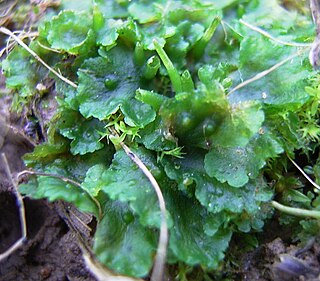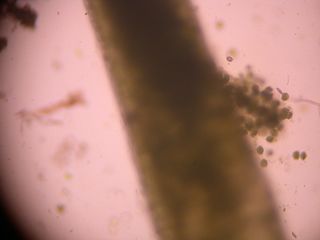
Bryophytes are a group of land plants, sometimes treated as a taxonomic division, that contains three groups of non-vascular land plants (embryophytes): the liverworts, hornworts and mosses. In the strict sense, Bryophyta consists of the mosses only. Bryophytes are characteristically limited in size and prefer moist habitats although they can survive in drier environments. The bryophytes consist of about 20,000 plant species. Bryophytes produce enclosed reproductive structures, but they do not produce flowers or seeds. They reproduce sexually by spores and asexually by fragmentation or the production of gemmae. Though bryophytes were considered a paraphyletic group in recent years, almost all of the most recent phylogenetic evidence supports the monophyly of this group, as originally classified by Wilhelm Schimper in 1879. The term bryophyte comes from Ancient Greek βρύον (brúon) 'tree moss, liverwort', and φυτόν (phutón) 'plant'.

The Marchantiophyta are a division of non-vascular land plants commonly referred to as hepatics or liverworts. Like mosses and hornworts, they have a gametophyte-dominant life cycle, in which cells of the plant carry only a single set of genetic information.

Hornworts are a group of non-vascular Embryophytes constituting the division Anthocerotophyta. The common name refers to the elongated horn-like structure, which is the sporophyte. As in mosses and liverworts, hornworts have a gametophyte-dominant life cycle, in which cells of the plant carry only a single set of genetic information; the flattened, green plant body of a hornwort is the gametophyte stage of the plant.

An antheridium is a haploid structure or organ producing and containing male gametes. The plural form is antheridia, and a structure containing one or more antheridia is called an androecium. Androecium is also the collective term for the stamens of flowering plants.

Sphaerocarpales is an order of plants within the liverworts. Approximately twenty species are in this order which is sub-divided into four families: Monocarpaceae, Sphaerocarpaceae and Riellaceae, as well as the extinct family Naiaditaceae. The inclusion of the Naiaditaceae is uncertain, and the family has sometimes been assigned to the Calobryales.

Dendroceros is a genus of hornworts in the family Dendrocerotaceae. The genus contains about 51 species native to tropical and sub-tropical regions of the world.

Megaceros is a genus of hornworts in the family Dendrocerotaceae. The genus is found in the Old World tropics of east Asia and Australia. Its name means 'big horn', and refers both to the exceptionally large size of the gametophyte thallus and to the large, horn-shaped sporophyte that the plants produce. Many species have a branching thallus that is more than two centimeters wide. The gametophytes are monoicous.
Notothylas is a genus of hornworts in the family Notothyladaceae. The genus is found globally, but is usually overlooked. It is the smallest of all the hornworts, with a yellow-green gametophyte thallus that is seldom more than a centimeter in diameter, and usually much smaller.

The Notothyladaceae is the only family of hornworts in the order Notothyladales.

Anthoceros is a genus of hornworts in the family Anthocerotaceae. It is distributed globally. Species of Anthoceros are characterized by having a small to medium-sized, green thallus that is more or less lobed along the margins.
Folioceros is a genus of hornworts in the family Anthocerotaceae. The genus is common locally in the tropical and subtropical regions of Asia, growing on moist rocks, in fallow fields, and near waterfalls. It has a yellow-green gametophyte thallus that is crispy and translucent, with short branchings that are almost pinnate. Plants are usually less than a centimeter wide and 3 centimeters long. They may be monoicous or dioicous.

Aneuraceae is a family of thallose liverworts in the order Metzgeriales. Most species are very small with narrow, branching thalli.
Leiosporoceros dussii is the only species in the hornwort genus Leiosporoceros. The species is placed in a separate family, order, and class for being "genetically and morphologically distinct from all other hornwort lineages." Cladistic analysis of genetic data supports a position at the very base of the hornwort clade. Physical characteristics that distinguish the group include unusually small spores that are monolete and unornamented. Additionally, there are unique strands of Nostoc (cyanobacteria) that grow inside the plant parallel with its direction of growth. Unlike other hornworts with symbiotic cyanobacteria that enters through mucilage clefts, the mucilage clefts in Leiosporoceros is only present in young plants and then closes permanently once the cyanobacterial colonies have been established. Also mycorrhiza and pyrenoids are absent. Male plants have been found in Panama.
Cyanobionts are cyanobacteria that live in symbiosis with a wide range of organisms such as terrestrial or aquatic plants; as well as, algal and fungal species. They can reside within extracellular or intracellular structures of the host. In order for a cyanobacterium to successfully form a symbiotic relationship, it must be able to exchange signals with the host, overcome defense mounted by the host, be capable of hormogonia formation, chemotaxis, heterocyst formation, as well as possess adequate resilience to reside in host tissue which may present extreme conditions, such as low oxygen levels, and/or acidic mucilage. The most well-known plant-associated cyanobionts belong to the genus Nostoc. With the ability to differentiate into several cell types that have various functions, members of the genus Nostoc have the morphological plasticity, flexibility and adaptability to adjust to a wide range of environmental conditions, contributing to its high capacity to form symbiotic relationships with other organisms. Several cyanobionts involved with fungi and marine organisms also belong to the genera Richelia, Calothrix, Synechocystis, Aphanocapsa and Anabaena, as well as the species Oscillatoria spongeliae. Although there are many documented symbioses between cyanobacteria and marine organisms, little is known about the nature of many of these symbioses. The possibility of discovering more novel symbiotic relationships is apparent from preliminary microscopic observations.
Cryptothallus is a previously recognized genus of liverworts in the family Aneuraceae. The plants are small, and are white to pale green as a result of lacking chlorophyll. This feature led to the creation of a separate genus. The morphology of species assigned to Cryptothallus is very similar to that of Aneura. As a result, Karen Renzaglia in 1982 suggested that the only species then placed in the genus, Cryptothallus mirabilis, may be considered "merely as an achlorophyllous species of Aneura." Wickett and Goffinet argued the same position on the basis of sequences of nuclear, mitochondrial, and plastid DNA, and moved Cryptothallus mirabilis to Aneura. A 2010 molecular phylogenetic study confirmed the position of Cryptothallus within Aneura. This was accepted in the 2016 world checklist of hornworts and liverworts.

The Anthocerotaceae is the only family of hornworts in the order Anthocerotales.

The Dendrocerotaceae is the only family of hornworts in the order Dendrocerotales.

Nothoceros is a genus of hornworts in the family Dendrocerotaceae. The genus is found in New Zealand, South America, and neotropical and eastern North America.
Phymatoceros is the only genus in the hornwort family Phymatocerotaceae and order Phymatocerotales. It includes only two species.

Casterlorum is a genus of fossil with controversial interpretation from the Middle Ordovician Douglas Lake Member of the Lenoir Limestone from Douglas Dam Tennessee The genus was named in honor of Ken Caster.










